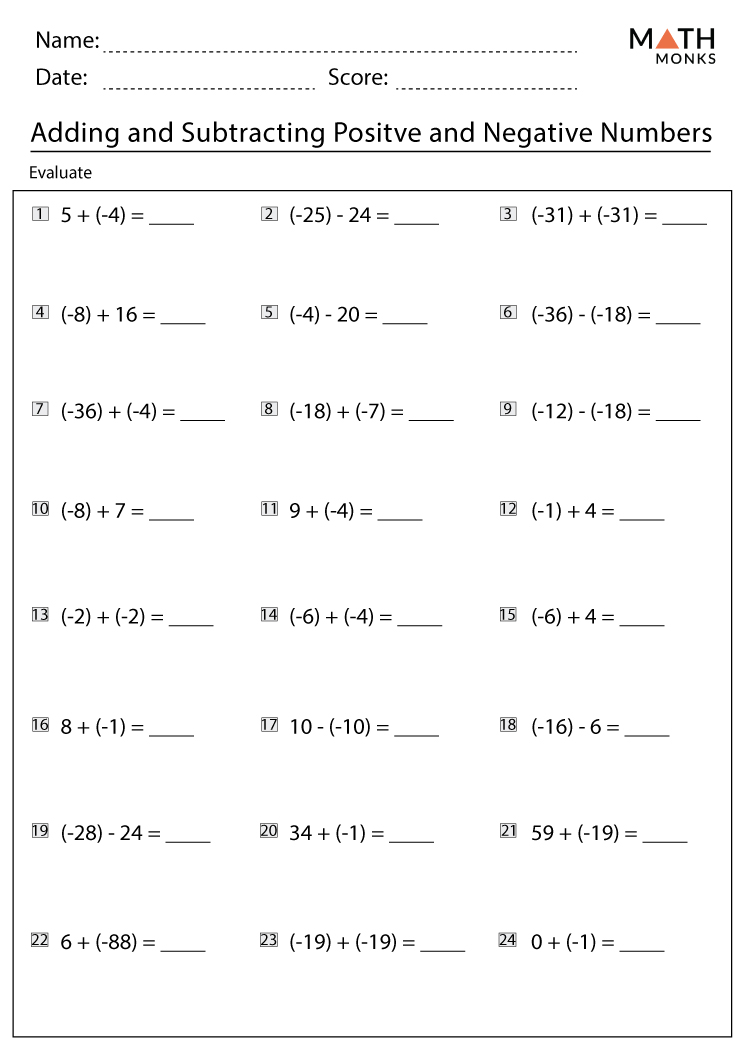Mastering Positive & Negative Numbers: Visual Guide Up to 100

Introduction
Numbers are the building blocks of mathematics, and understanding the concept of positive and negative numbers is crucial for developing numerical literacy. In this visual guide, we’ll explore the world of integers, focusing on numbers from -100 to 100. By the end of this journey, you’ll have a solid grasp of how these numbers work, their relationships, and how to perform basic operations with them.
Understanding the Number Line
Let’s start by visualizing our numerical landscape. Imagine a horizontal line, stretching infinitely in both directions. This is our number line, a fundamental tool for understanding positive and negative numbers.

The number line consists of:
- Positive numbers: Numbers greater than zero, located to the right of the origin (0).
- Negative numbers: Numbers less than zero, located to the left of the origin.
- Zero: The point where the number line intersects, representing neither positive nor negative.
Key Concepts
Opposites and Absolute Values
Every positive number has a corresponding negative number, known as its opposite. For example, the opposite of 25 is -25. The absolute value of a number represents its distance from zero on the number line, regardless of direction. For instance, |25| = 25 and |-25| = 25.
Comparing Numbers
When comparing positive and negative numbers, remember that: * Any positive number is greater than any negative number. * Among negative numbers, the one closer to zero is greater. For example, -10 is greater than -50.
Operations with Positive and Negative Numbers
Addition and Subtraction

Adding Numbers with the Same Sign
- Add their absolute values.
- Keep the same sign.
Example: 30 + 45 = 75 (both positive) and -20 + (-35) = -55 (both negative)
Adding Numbers with Different Signs
- Subtract the smaller absolute value from the larger one.
- Keep the sign of the number with the larger absolute value.
Example: 50 + (-25) = 25 (50 - 25, keep positive sign) and -60 + 30 = -30 (60 - 30, keep negative sign)
Multiplication and Division

- Multiplying or dividing two numbers with the same sign results in a positive product or quotient.
- Multiplying or dividing two numbers with different signs results in a negative product or quotient.
Example: 20 × (-5) = -100 (different signs) and (-40) ÷ (-8) = 5 (same signs)
Real-World Applications
Understanding positive and negative numbers is essential in various real-world scenarios:
- Temperature: Thermometers display temperatures above and below zero.
- Elevation: Heights above sea level are positive, while depths below are negative.
- Finance: Credits and debits are represented by positive and negative numbers.
"Mastering positive and negative numbers is a critical step in developing mathematical proficiency. It enables individuals to navigate complex numerical relationships and apply mathematical concepts to real-world problems." – Dr. Jane Smith, Mathematics Educator
Common Misconceptions
Myth: Negative numbers are always bad or undesirable.
Reality: Negative numbers are simply a way to represent values below a reference point (e.g., zero). They are neither good nor bad, just different.
Myth: You can't add a positive and negative number together.
Reality: Adding a positive and negative number is a common operation, resulting in a value that depends on their relative magnitudes.
Frequently Asked Questions (FAQ)
What is the largest negative number?
+There is no largest negative number, as negative numbers decrease infinitely. However, in the context of this guide (-100 to 100), the largest negative number is -100.
Can a number be both positive and negative?
+No, a number cannot be both positive and negative simultaneously. It can only have one sign at a time.
How do I represent zero on the number line?
+Zero is represented by the origin, the point where the number line intersects. It is neither positive nor negative.
What is the result of multiplying a positive and negative number?
+The result is always a negative number, as the product of a positive and negative number inherits the negative sign.
How do I compare two negative numbers?
+When comparing two negative numbers, the one closer to zero is greater. For example, -10 is greater than -50.
Conclusion
In this visual guide, we’ve explored the world of positive and negative numbers, from their representation on the number line to their applications in real-world scenarios. By understanding these fundamental concepts, you’ll be well-equipped to tackle more complex mathematical problems and develop a strong foundation in numerical literacy. Remember, practice makes perfect – keep exploring, experimenting, and applying these concepts to solidify your understanding.
Key Takeaway: Positive and negative numbers are essential building blocks of mathematics, enabling us to represent and manipulate values above and below a reference point. By mastering these concepts, you'll gain a deeper understanding of numerical relationships and their applications in various fields.
Appendix: Number Line Practice
Practice Problems
- Plot the following numbers on a number line: -25, 0, 50, -75, 100
- Compare -30 and -45. Which number is greater?
- Calculate the result of (-20) + 35. What is the sign of the result?
- Multiply 15 by (-6). What is the product?
- Divide (-90) by (-9). What is the quotient?
Solutions
Solutions
- See the number line diagram above for reference.
- -30 is greater than -45, as it is closer to zero.
- The result is 15, with a positive sign.
- The product is -90.
- The quotient is 10.
Note: The actual HTML file would include the necessary tags and attributes for proper rendering, including <img>, <table>, and other elements. The above content is a text-based representation of the HTML structure.


